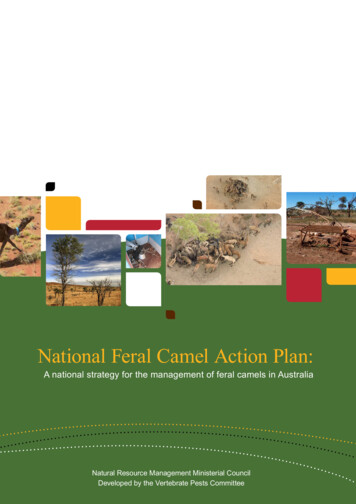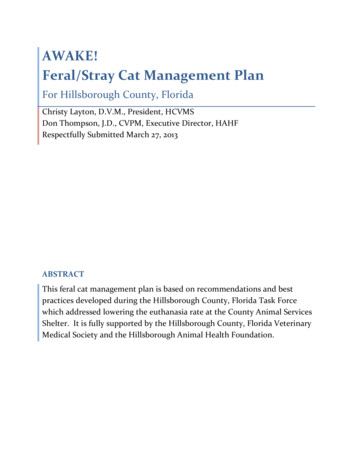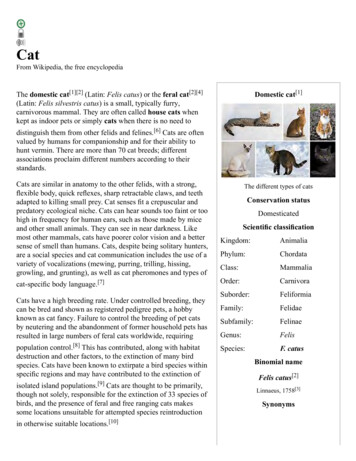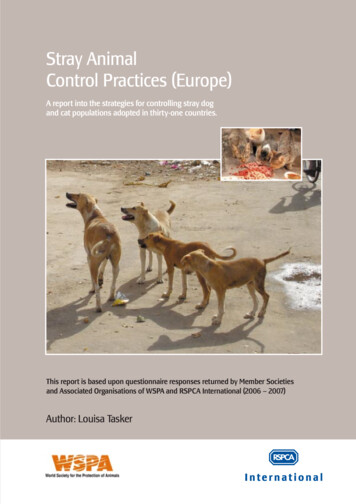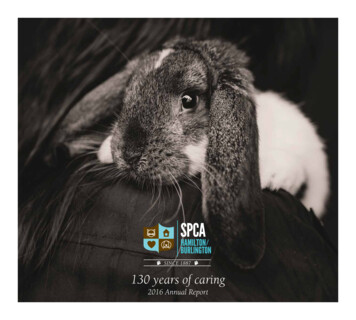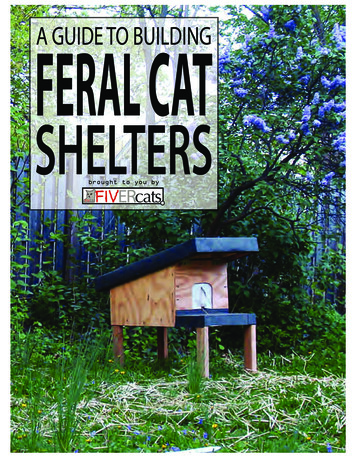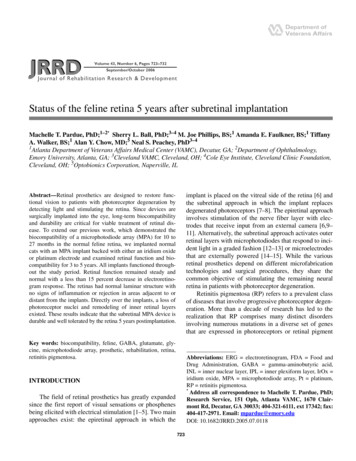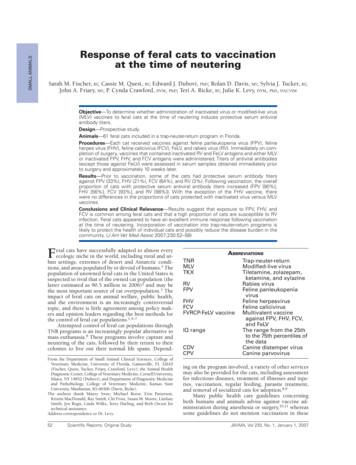
Transcription
SMALL ANIMALSResponse of feral cats to vaccinationat the time of neuteringSarah M. Fischer, bs; Cassie M. Quest, bs; Edward J. Dubovi, phd; Rolan D. Davis, ms; Sylvia J. Tucker, bs;John A. Friary, ms; P. Cynda Crawford, dvm, phd; Teri A. Ricke, bs; Julie K. Levy, dvm, phd, dacvimObjective—To determine whether administration of inactivated virus or modified-live virus(MLV) vaccines to feral cats at the time of neutering induces protective serum antiviralantibody titers.Design—Prospective study.Animals—61 feral cats included in a trap-neuter-return program in Florida.Procedures—Each cat received vaccines against feline panleukopenia virus (FPV), felineherpes virus (FHV), feline calicivirus (FCV), FeLV, and rabies virus (RV). Immediately on completion of surgery, vaccines that contained inactivated RV and FeLV antigens and either MLVor inactivated FPV, FHV, and FCV antigens were administered. Titers of antiviral antibodies(except those against FeLV) were assessed in serum samples obtained immediately priorto surgery and approximately 10 weeks later.Results—Prior to vaccination, some of the cats had protective serum antibody titersagainst FPV (33%), FHV (21%), FCV (64%), and RV (3%). Following vaccination, the overallproportion of cats with protective serum antiviral antibody titers increased (FPV [90%],FHV [56%], FCV [93%], and RV [98%]). With the exception of the FHV vaccine, therewere no differences in the proportions of cats protected with inactivated virus versus MLVvaccines.Conclusions and Clinical Relevance—Results suggest that exposure to FPV, FHV, andFCV is common among feral cats and that a high proportion of cats are susceptible to RVinfection. Feral cats appeared to have an excellent immune response following vaccinationat the time of neutering. Incorporation of vaccination into trap-neuter-return programs islikely to protect the health of individual cats and possibly reduce the disease burden in thecommunity. (J Am Vet Med Assoc 2007;230:52–58)Feral cats have successfully adapted to almost everyecologic niche in the world, including rural and urban settings, extremes of desert and Antarctic conditions, and areas populated by or devoid of humans.1 Thepopulation of unowned feral cats in the United States issuspected to rival that of the owned cat population (thelatter estimated as 90.5 million in 2006)2 and may bethe most important source of cat overpopulation.3 Theimpact of feral cats on animal welfare, public health,and the environment is an increasingly controversialtopic, and there is little agreement among policy makers and opinion leaders regarding the best methods forthe control of feral cat populations.1,4–7Attempted control of feral cat populations throughTNR programs is an increasingly popular alternative tomass euthanasia.8 These programs involve capture andneutering of the cats, followed by their return to theircolonies to live out their normal life spans. DependFrom the Department of Small Animal Clinical Sciences, College ofVeterinary Medicine, University of Florida, Gainesville, FL 32610(Fischer, Quest, Tucker, Friary, Crawford, Levy); the Animal HealthDiagnostic Center, College of Veterinary Medicine, Cornell University,Ithaca, NY 14852 (Dubovi); and Department of Diagnostic Medicineand Pathobiology, College of Veterinary Medicine, Kansas StateUniversity, Manhattan, KS 66506 (Davis, Ricke).The authors thank Maury Swee, Michael Reese, Erin Patterson,Kristin MacDonald, Ray Smith, Chi Frost, Susan M. Moore, LindsaySmith, Jen Regis, Linda Wilks, Terry Darling, and Beth Orcutt fortechnical assistance.Address correspondence to Dr. Levy.52Scientific Reports: Original -live virusTKXTiletamine, zolazepam,ketamine, and xylazineRVRabies virusFPVFeline panleukopeniavirusFHVFeline herpesvirusFCVFeline calicivirusFVRCP-FeLV vaccine Multivalent vaccineagainst FPV, FHV, FCV,and FeLVIQ rangeThe range from the 25thto the 75th percentiles ofthe dataCDVCanine distemper virusCPVCanine parvovirusing on the program involved, a variety of other servicesmay also be provided for the cats, including assessmentfor infectious diseases, treatment of illnesses and injuries, vaccination, regular feeding, parasite treatment,and removal of socialized cats for adoption.8,9Many public health care guidelines concerningboth humans and animals advise against vaccine administration during anesthesia or surgery,10,11 whereassome guidelines do not mention vaccination in theseJAVMA, Vol 230, No. 1, January 1, 2007
Materials and MethodsCats—Sixty-one cats collected from 12 coloniesin north and south Florida from March to July 2005were included in the study. All cats were feral; freeroaming; to our knowledge, unowned; and unaccustomed to being handled. To the caretaker’s knowledge,none of the cats had received veterinary care previously, but because the history of most cats was unknown, this could not be confirmed. Cats were captured for surgery in wire trapsa that were baited withcanned fish by colony caretakers and captured againapproximately 10 weeks after surgery for reevaluation.Veterinary care, including anesthesia, neutering, vaccination, and parasiticide treatment, was provided bya nonprofit TNR program according to its usual practices.b The research protocol was approved by the University of Florida Institutional Animal Care and UseCommittee and was conducted in facilities accreditedby the Association for Assessment and Accreditationof Laboratory Animal Care International.Anesthesia—Each cat was anesthetized via IM injection of a combination of tiletaminec (9.6 mg), zolazepamc (9.6 mg), ketamined (19.2 mg), and xylazinee(4.8 mg) while still confined in the trap.26,27 Isofluranef was administered via face mask, or an additionalJAVMA, Vol 230, No. 1, January 1, 2007dose of TKX was administered if needed to maintaina surgical plane of anesthesia. After surgery and whenall procedures had been completed, anesthesia was partially reversed with yohimbineg (0.6 mg, IV). A rectalbody temperature measurement was made at the timeof anesthetic reversal. Cats were then returned to theirwire traps for recovery. Time from injection of TKX toinjection of yohimbine was recorded as total durationof anesthesia.Sample collection—After anesthesia was achieved,6 mL of blood was collected via jugular venipunctureand placed into a serum separator tube. Samples wereallowed to clot for at least 30 minutes and then centrifuged for 20 minutes. Serum was collected and storedat –20 C pending analysis.Surgery and treatment—Once anesthetized, eachcat was briefly examined and recordings made of bodyweight, physical findings, and age estimate (based onbody weight and dentition). Cats that weighed 2 kg(4.4 lb) with deciduous canine teeth were judged to be4 to 6 months of age (juveniles), and cats with permanent canine teeth were judged to be 6 months of age(adults). Only cats estimated to be at least 4 monthsof age were included in the study to avoid interferenceof immune responses attributable to passive transferof maternal antibodies. Each cat was prepared for surgery by applying lubricant to each eye, administrationof a single dose of penicillin G benzathine-procaineh(100,000 units [50,000 units in juveniles], SC), removalof the tip of the left ear for visual identification of itsneutered status, clipping of the hair from the incisionsite, and cleaning of the skin with povidone-iodine scrubsolution and alcohol. Ovariohysterectomy or castrationwas performed by standard techniques. The presence ofconcurrent conditions, such as lactation and pregnancy,as well as the administration of additional anestheticagents to maintain surgical plane of anesthesia were recorded. After surgery, an identification microchipi wasimplanted SC in the interscapular area and a parasiticide(selemectinj) was applied to the skin prior to reversal ofanesthesia. The cats were held in their traps for 24 hoursafter surgery, then released back to their colonies.Vaccination—Vaccines were administered immediately after surgery by use of a 3-mL syringe with a22-gauge needle. In each cat, an inactivated RV vaccinethat is licensed for 3-year duration of immunityk wasadministered SC in the right hind limb just distal tothe stifle joint. Each cat also received 1 of 2 formulations of an FVRCP-FeLV vaccine administered SC inthe left hind limb just distal to the stifle joint. For approximately half of the cats, the FVRCP component ofthe vaccine contained inactivated virusesl; and for theremaining cats, the FVRCP component of the vaccinecontained MLVs.m The FeLV in both types of FVRCPFeLV vaccine was inactivated.Follow-up procedures—The cats were recapturedapproximately 2 months later, and their identificationwas confirmed by interrogation of the microchip. Catswere briefly sedated with medetomidine (100 µg/kg[45 µg/lb], IM). A blood sample (6 mL) was collectedfrom each cat and processed (as described), and a bodyScientific Reports: Original Study53SMALL ANIMALScircumstances.12 Other guidelines encourage perioperative vaccinations when nosocomial risks are high, inemergency situations, or when compliance with vaccination at a later time is deemed unlikely.13 Safety is 1consideration because anesthesia may mask the signsof acute adverse reactions and thus impede necessaryemergency intervention. The efficacy of vaccinationunder such conditions is also questioned because psychologic stress, anesthesia, and surgery all have markedimpacts on innate immune responses such as leukocytetrafficking, cytokine elaboration, phagocyte function,and mitogenesis and on acquired immune responsesincluding delayed-type hypersensitivity reactions, Band T-cell proliferation, and antibody production.14–25Vaccines are not tested in the context of anesthesia andsurgery during licensing studies, so efficacy remainsundetermined in such circumstances. Despite theseuncertainties, the limitations associated with deliveringveterinary care to wild populations (such as feral cats)dictate that deviations from standards of care designedfor pets are sometimes required.The vaccination policies of TNR programs vary according to the resources available to the programs andto the beliefs of the supervising veterinarians regarding the effectiveness and necessity of vaccination underthe conditions of a TNR clinic.8 Many TNR programsdo not vaccinate cats because of the belief that a singledose of vaccine administered under the stressful conditions of capture, transport, anesthesia, and surgery islikely to be ineffective. The purpose of the study reported here was to determine whether administrationof inactivated virus or MLV vaccines to feral cats at thetime of neutering effectively induces protective serumantiviral antibody titers. In addition, we intended tocompare the serologic responses to the inactivated virusand MLV vaccines.
SMALL ANIMALSweight measurement was obtained. A booster injectionof FVRCP-FeLV vaccinem was administered, and sedation was reversed with atipamazole (0.125 mg, SC).The cats were replaced in their traps and returned totheir colonies the same day.Serologic assessments—Laboratory personnelwho performed sample testing were unaware of thetype of vaccine administered and the timing of thesample collection. Antiviral antibody titers in thepaired serum samples were determined via hemagglutination inhibition (antibodies against FPV),n virusneutralization (antibodies against FHV and FCV),nand virus neutralization by the rapid fluorescent focusinhibition test (antibodies against RV).o Previous correlation of titers with protection against virulent challenge has established that the reciprocal serum antibody titer that was protective against FPV, FHV, andFCV was 40, 16, and 32, respectively; these titers havebeen accepted as an indication of adequate response tovaccination.28,29 A serum anti-RV antibody titer 25is consistent with nonspecific serum antiviral activity,whereas a titer 25 is considered to be indicative ofeffective immunization against RV, although the actualprotective titer has not been determined for cats.30 Forthe purposes of statistical analysis, a titer of 25 wasconsidered adequate for protection against RV. Becauseserum antibody titers are not correlated with protection against FeLV, these were not measured; however,the serum sample obtained prior to vaccination wasalso tested for FeLV antigen and FIV antibody by useof an ELISA.pStatistical analysis—For the groups receiving inactivated or MLV vaccines, duration of anesthesia; postoperative rectal temperature; body weight at the timeof surgery, body weight at the time of recapture, andchange in body weight; interval between release and recapture; and serum antiviral antibody titers were compared by use of the Mann-Whitney rank sum test. Byuse of χ2 tests, the proportions of cats in each groupwith regard to age, sex, and development of protectiveantiviral antibody titers were compared. A value of P 0.05 was considered significant.ResultsCats—Sixty-one feral cats were enrolled in thestudy; the population comprised 35 (57%) females and26 (43%) males, of which 56 (92%) were adults and 5(8%) were juveniles (Table 1). The cats were randomized to receive inactivated virus vaccines (n 32) orMLV vaccines (29). There was no significant differencein the proportion of female cats between the 2 groups,but the MLV vaccine group contained a higher proportion (P 0.02) of juveniles (5/29 [17%] cats) than theinactivated-virus vaccine group (0/32 [0%] cats). Therewere no differences (P 0.5) in any of the variablesother than age between the inactivated-virus and theMLV vaccine groups. Eight cats were pregnant (5 inthe inactivated-virus vaccine group and 3 in the MLVvaccine group), and 5 cats were lactating (3 cats in theinactivated-virus vaccine group and 2 cats in the MLVvaccine group). One male cat in the inactivated-virusvaccine group was seropositive for anti-FIV antibody,and 1 male cat in the MLV vaccine group was seropositive for both FeLV antigen and anti-FIV antibody. Additional anesthesia was provided to 1 cat in each groupvia inhalation of isoflurane and to 3 cats in the MLVvaccine group by additional administration of TKX.Mean SD duration of anesthesia for all cats was 44 25 minutes, and mean temperature at the time of anesthetic reversal was 36.4 1.1 C (97.6 2.0 F).Among all 61 cats, the mean interval between release after surgery and recapture was 10.1 2.7 weeks.Mean body weight was 2.95 0.71 kg (6.5 1.6 lb) atthe time of surgery and 3.34 0.75 kg (7.3 1.7 lb)at the time of recapture. The cats’ body weight significantly (P 0.008) increased (a mean difference of 14 13%) between the 2 time points. Among the 61 cats, 51(84%) gained weight, 3 (5%) had no change in weight,and 7 (11%) lost weight.Serum anti-FPV antibody titers—Among the 61cats, 28 (46%) had serum antibodies against FPV (median titer, 0; IQ range, 0 to 800) at the time of surgery,indicating previous exposure or vaccination, but only20 (33%) had titers in the protective range. Prior to vaccination, median titer and proportion of cats protectedTable 1—Characteristics of 61 anesthetized feral cats that received an FVRCPFeLV vaccine (either inactivated viruses [n 32] or MLVs [29]) in addition to aninactivated virus vaccine against RV at the time of neutering.Vaccine groupVariableInactivated virus*MLV†3263100‡42 1836.4 0.9 (97.5 1.7)29528347 3136.4 1.3 (97.6 2.3)Body weight before3.08 0.65 (6.7 1.4)surgery (kg [lb])Body weight at recapture (kg [lb]) 3.43 0.77 (7.5 1.7)Body weight gain (%)12 11Recapture interval (wk)9.8 1.62.84 0.76 (6.2 1.7)No. of catsFemale cats (%)Adult cats (%)Duration of anesthesia (min)Rectal temperatureafter surgery ( C [ F])3.25 0.72 (7.2 1.6)16 1510.4 3.6*FVRCP-FeLV (inactivated viruses) and RV (inactivated virus) vaccines. †FVRCPFeLV (MLVs; inactivated FeLV) and RV (inactivated virus) vaccines. ‡ Significant (P 0.05) difference in this variable between vaccine groups.54Scientific Reports: Original StudyJAVMA, Vol 230, No. 1, January 1, 2007
Serum anti-FHV antibody titers—Among the 61cats, 17 (28%) had serum antibodies against FHV (median titer 0; IQ range, 0 to 4), indicating previous exposure or vaccination, but only 13 (21%) had titers in theprotective range. Prior to vaccination, median titer andproportion of protected cats were not significantly (P 0.3) different between the inactivated-virus and MLVvaccine groups (Tables 2 and 3). Median titer (24; IQrange, 4 to 48) and proportion of cats that had protective anti-FHV antibody titers (34/61 [56%]) increasedsignificantly (P 0.001) following vaccination. Theproportion of cats with protective anti-FHV antibodytiters after vaccination was significantly (P 0.001)higher in the inactivated-virus vaccine group than inthe MLV vaccine group. Compared with values beforesurgery, the proportion of protected cats increased significantly (P 0.001) following administration of theinactivated virus vaccine, but there was no change (P 1.0) in the proportion of protected cats following administration of the MLV vaccine. Also, the median titerafter vaccination for cats in the inactivated-virus vaccine group was higher (P 0.001) than the value forcats in the MLV vaccine group.Serum anti-FCV antibody titers—Among the 61cats, 55 (90%) had antibodies against FCV (median titer, 256; IQ range, 8 to 2,048), indicating previous exposure or vaccination, but only 39 (64%) had titers in theprotective range. Prior to vaccination, the median titerin the inactivated-virus and MLV vaccine groups wasnot significantly (P 0.8) different, but the proportionof cats with protective titers was significantly (P 0.02)higher in the inactivated-virus vaccine group (Tables2 and 3). Median titer (768; IQ range, 176 to 4,096)and the proportion of cats that had protective anti-FCVantibody titers (57/61 [93%]) increased significantly (P 0.003) following vaccination. The median titer andproportion of cats with protective anti-FCV antibodytiters did not differ significantly (P 0.6) between theinactivated-virus and MLV vaccine groups.Serum anti-RV antibody titers—Cats in both treatment groups received the same inactivated RV vaccine.Only 2 (3%) cats had antibodies against RV (titer, 25),indicating previous exposure or vaccination (Tables2 and 3). For 5 other cats, titers 25 were detected,which is consistent with nonspecific serum virus neutralizing activity. Median titer (5,300; IQ range, 1,400to 9,075) and the proportion of cats that had protectiveanti-RV antibody titers (60/61 [98%]) increased significantly (P 0.001) following vaccination. Only 1 catJAVMA, Vol 230, No. 1, January 1, 2007Table 2—Median (IQ range) serum antiviral antibody titers in61 anesthetized feral cats before and approximately 10 weeksafter administration of an FVRCP-FeLV vaccine (either inactivatedviruses [n 32] or MLVs [29]) in addition to an inactivated vaccineagainst RV.Vaccine groupSerum antiviralantibody titerFPVBefore vaccinationAfter vaccinationFHVBefore vaccinationAfter vaccinationFCVBefore vaccinationAfter vaccinationRVBefore vaccinationAfter vaccinationInactivated virus*MLV†0 (0–10)160 (60–640)‡,§10 (0–1,280)2,560 (1,280–3,200)§0 (0–4)40 (16–48)‡,§0 (0–16)4 (0–32)§512 (80–1,536)768 (448–3,584)§24 (8–4,096)768 (60–6,144)§0 (0–0)0 (0–0)5,850 (2,400–13,812)§ 2,400 (1,025–8,500)§§Value significantly (P 0.05) different from the value beforevaccination for this variable.See Table 1 for remainder of key.Table 3—Proportion of anesthetized feral cats (n 61) thatreceived an FVRCP-FeLV vaccine (either inactivated viruses orMLVs) in addition to an inactivated virus vaccine against RV andthat had protective serum antiviral antibody titers before andapproximately 10 weeks after vaccination.No. of cats (%)Serum antiviralantibody titerInactivated virusvaccine group*(n 32)FPVBefore vaccinationAfter vaccinationFHVBefore vaccinationAfter vaccinationFCVBefore vaccinationAfter vaccinationRVBefore vaccinationAfter vaccination7 (22)27 (84)§5 (16)26 (81)‡,§MLV virusvaccine group†(29)13 (45)28 (97)§8 (28)8 (28)25 (78)‡30 (94)14 (48)27 (93)§1 (3.1)32 (100)§1 (3.5)28 (97)§See Tables 1 and 2 for key.failed to develop an acceptable anti-RV antibody titerfollowing vaccination; this male cat was infected withboth FeLV and FIV.In most cats, failure to respond to 1 antigen did notcorrelate with failure to respond to other antigens thatwere administered at the same time. One cat, a pregnantfemale, failed to respond to any of the FPV, FHV, FCVantigens, yet had an excellent response to RV. Anothercat, a male infected with both FeLV and FIV, had no response to RV and remained seronegative for that virus.This cat had protective serum antibody titers againstFPV, FHV, and FCV at the time of surgery, but at thetime of reevaluation, there was no detectable boostereffect associated with vaccine administration.DiscussionIn the present study, a substantial number ofthe 61 feral cats that underwent neutering had serologic evidence of previous exposure to or vaccinationagainst FPV (46%), FHV (28%), and FCV (90%). ThisScientific Reports: Original Study55SMALL ANIMALSwere not significantly (P 0.06) different between theinactivated-virus and MLV vaccine groups (Tables 2and 3). Median titer (640; IQ range, 160 to 2,560) andproportion of cats that had protective anti-FPV antibody titers (55/61 [90%] cats) increased significantly(P 0.001) following vaccination. The proportion ofcats with protective anti-FPV antibody titers after vaccination did not differ significantly (P 0.2) between theinactivated-virus and MLV vaccine groups. However,cats in the MLV vaccine group had higher (P 0.001)median titers after vaccination, compared with cats inthe inactivated-virus vaccine group.
SMALL ANIMALSis consistent with previous reports of seropositivityin unvaccinated feral cats for FPV (8% to 79%), FHV(11% to 19%), and FCV (54% to 77%) in diverse locales including Wisconsin,q Australia,31 Saudi Arabia,32and Vietnam.33 Although it is possible that some catsin the study reported here received previous FVRCPtype vaccines without the knowledge of the caretakers, the marked variation in seropositivity for the3 viruses suggests that natural exposure was common. Seven (11%) cats had virus neutralizing activityagainst RV prior to vaccination, but only 2 (3%) hadtiters that were high enough to be considered specificfor anti-RV antibodies. Low seropositivity rates havebeen determined for other species living in rabies-endemic areas and indicate nonspecific assay reactions,previous vaccination, or nonfatal exposure to RV.34,35Although assessment of serum antibodies is only1 measure of disease resistance, the additional contributions of age-related natural resistance, cell-mediatedimmunity, and timing and virulence of challenge exposure are more difficult to quantify. Based on serologicfindings alone, it appears that more than half of the catsin the present study may have been susceptible to FPV,FHV, and RV infections. In contrast, most cats had protective serum anti-FCV antibody titers prior to vaccination. Thus, it appears that a substantial proportion offeral cats are susceptible to infection and that feral catshave a high risk of natural exposure to preventable viraldiseases.In the present study, serologic responses of feralcats that were vaccinated immediately after surgerywhile still under anesthesia were evaluated. Althoughmost cats appeared healthy, several had coexistingconditions such as pregnancy, lactation, and retroviralinfection; generally, the study cats were representative of feral cats admitted to large-scale TNR programsin the United States.8,36 After surgery, the cats werereturned to their natural environments and then recaptured approximately 10 weeks later to determineserologic responses to vaccination. Overall, a highpercentage of cats developed protective titers of serum antibodies against FPV (90%), FHV (56%), FCV(93%), and RV (98%). Vaccination of feral cats at thetime of neutering may protect them for much of theirremaining life span because immunity that developsfollowing vaccination has been shown to persist for aminimum of 3 to 7 years in most cats.28,29,37–39 Ideally,feral cats should be recaptured and receive boostervaccinations, particularly with a vaccine against RV,according to the guidelines established by the American Association of Feline Practitioners.40The 2 FVRCP-FeLV vaccines used in the presentstudy contained inactivated viruses or MLVs, and bothinduced protective antiviral antibody titers in mostcats. An exception was the failure of the MLV vaccine toincrease the proportion of cats protected against FHV(28% before and after vaccination). In contrast, the inactivated virus vaccine increased the proportion of catswith protective anti-FHV antibody titers from 16% to81%. However, administration of the MLV vaccine resulted in higher anti-FPV antibody titers and a higherproportion of cats protected against FPV, comparedwith the inactivated virus vaccine, although the latter56Scientific Reports: Original Studydifference was not significant. In our study, vaccinesfrom only 1 vaccine manufacturer were used. Becausedifferences in vaccine composition are likely to existamong the various vaccine preparations that are currently available, caution should be used when extrapolating findings to vaccines from other manufacturers. Inaddition, serologic evaluation of the cats was performedat only 1 time point after vaccination. Although acceptable serologic responses were detected in most cats, itis not possible to project the kinetics of the immune response over time. It is possible that serologic responsesin the inactivated-virus and MLV vaccine groups wouldbe different at other time points if the initial immuneresponse and antibody titer decay rates are not the samefor both types of vaccine.Failure to develop acceptable titers following vaccination against RV was reported for 2.8% (62/2,188)of pet cats participating in the Pet Travel Scheme monitoring program required for importation of cats to theUnited Kingdom.30 The failure rate was highest whencats were tested 8 weeks after vaccination, comparedwith findings at shorter intervals. Interestingly, sexuallyintact male cats were most likely to fail to respond toRV vaccination. On the basis of these results, it appearsthat feral cats vaccinated against RV at the time of surgery have a similar response rate as pet cats undergoingroutine vaccination in veterinary clinics. In addition toindividual variation in serologic responsiveness to specific antigens, other reasons for vaccine failures includedamaged vaccines; improper administration (such asmistakenly injecting the vaccine into a cat’s hair); andindividual patient responses that are influenced by age,sex, genetic background, and health status.Several studies41–44 have evaluated the effect ofanesthesia and surgery on responses to vaccination indogs, but no reports of similar studies in cats are knownto the authors. In 1 study,41 healthy dogs aged 4 to 6months were vaccinated against CDV without othertreatments (control dogs) or during a standardized anesthetic and surgery procedure in which the abdominalcavity was opened, the viscera were manipulated, andthen the incision site was closed. All dogs developedprotective anti-CDV antibody titers within 14 days, andthere was no difference in the mean antibody titer between the groups. In another study,42 6-week-old puppies were vaccinated against CPV and RV either withoutanesthesia (control dogs) or during an anesthetic event.Maternal antibodies were present against both CPV andRV at the time of vaccination, which would be expectedto interfere with response to vaccination in some ofthe puppies. Mean antibody titer was increased in bothgroups at 10 and 20 days after vaccination; anti-CPVantibody titers were similar in control and anesthetizedpuppies, but mean anti-RV antibody titers were higherin the control group. In a third report,43 client-owneddogs were vaccinated from 10 days before to 3 days after surgery; at 2 weeks after vaccination, serum titers ofantibodies against CPV and CDV were increased frombaseline values. The effect of immunosuppressive dosesof corticosteroids on immune responses to vaccinationin dogs was evaluated in young Beagles that received atapering dose of prednisolone for 3 weeks, starting at adosage of 2 to 20 mg/kg/d (0.9 to 9.1 mg/lb/d).44 TheyJAVMA, Vol 230, No. 1, January 1, 2007
6.7.8.9.10.11.12.13.14.15.16.a.b.Model 106, Tomahawk live trap, Tomahawk, Wis.Operation Catnip, Gainesville, Fla.JAVMA, Vol 230, No. 1, January 1, 2007Telazol, Fort Dodge Animal Health, Fort Dodge, Iowa.Ketaset, Fort Dodge Animal Health, Fort Dodge, Iowa.Xyla-Ject, Phoenix Pharmaceutical Inc, St Joseph, Mo.Isoflo, Abbott Laboratories, North Chicago, Ill.Yobine, Lloyd Laboratories, Shenandoah, Iowa.Sterile penicillin G benzathine and penicillin G procaine, GCHanford Manufacturing Co, Syracuse, NY.AVID microchip identification system, AVID Identification Systems Inc, Folsom, La.Revolution, Pfizer Animal Health, New York, NY.Rabvac 3 TF, Fort Dodge Animal Health, Fort Dodge, Iowa.Fel-O-Vax-Lv-K III, Fort Dodge Animal Health, Fort Dodge,Iowa.Fel-O-Guard Plus 3 and Fel-O-Vax-Lv-K, Fort Dodge AnimalHealth, Fort Dodge, Iowa.Animal Health Diagnostic Center, College of Veterinary Medicine, Cornell University, Ithaca, NY.Department of Diagnostic Medicine and Pathobiology, College ofVeterinary Medicine, Kansas State University, Manhattan, Kan.SNAP FIV antibody/FeLV antigen combo test, IDEXX Laboratories, Westbrook, Me.Haase C, Larson LJ, Peek L, et al. Feral cats in Dane County,Wisconsin, are found to have exceptionally low prevalence ofinfectious diseases (abstr), in Proceedings. Conf Res WorkersAnim Dis 84th Annu Meet 2003;88.Levy JK, Crawford PC. Humane strategies for controlling f
Smith, Jen Regis, Linda Wilks, Terry Darling, and Beth Orcutt for technical assistance. Address correspondence to Dr. Levy. Objective—To determine whether administration of inactivated virus or modified-live virus (MLV) vaccines to feral cats at the time of neutering induces protective serum antiviral antibody titers. Design—Prospective study.
